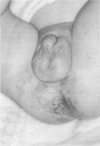Abstract
We report a patient with acrodermatitis enteropathica and a normal serum zinc level in whom the diagnosis was confirmed by plasma phospholipid fatty acid and a small bowel biopsy response to oral zinc therapy. Acrodermatitis enteropathica is a rare autosomal recessive condition of zinc deficiency characterised by chronic diarrhoea associated with failure to thrive, periorificial dermatitis and alopecia, susceptibility to infections and behavioural changes. Diagnosis is usually established by reduced serum zinc levels (classical acrodermatitis enteropathica). Paneth cell abnormalities on electron microscope of a small bowel biopsy can be supportive. A few cases with the typical picture of acrodermatitis enteropathica without hypozincaemia (variant acrodermatitis enteropathica) have been described. The diagnosis of variant acrodermatitis enteropathica to date has been based on an entirely empiric, but nonetheless convincing clinical response to oral zinc therapy. Laboratory aids to diagnosis have been lacking.
Full text
PDF



Images in this article
Selected References
These references are in PubMed. This may not be the complete list of references from this article.
- Aggett P. J. Acrodermatitis enteropathica. J Inherit Metab Dis. 1983;6 (Suppl 1):39–43. doi: 10.1007/BF01811322. [DOI] [PubMed] [Google Scholar]
- Aggett P. J., Harries J. T. Current status of zinc in health and disease states. Arch Dis Child. 1979 Dec;54(12):909–917. doi: 10.1136/adc.54.12.909. [DOI] [PMC free article] [PubMed] [Google Scholar]
- Bohane T. D., Cutz E., Hamilton J. R., Gall D. G. Acrodermatitis enteropathica, zinc, and the Paneth cell. A case report with family studies. Gastroenterology. 1977 Sep;73(3):587–592. [PubMed] [Google Scholar]
- Cunnane S. C. Role of zinc in lipid and fatty acid metabolism and in membranes. Prog Food Nutr Sci. 1988;12(2):151–188. [PubMed] [Google Scholar]
- Garretts M., Molokhia M. Acrodermatitis enteropathica without hypozincemia. J Pediatr. 1977 Sep;91(3):492–494. doi: 10.1016/s0022-3476(77)81333-4. [DOI] [PubMed] [Google Scholar]
- Jones J. G., Elmes M. E., Aggett P. J., Harries J. T. The effect of zinc therapy on lysosomal inclusion bodies in intestinal epithelial cells in acrodermatitis enteropathica. Pediatr Res. 1983 May;17(5):354–357. doi: 10.1203/00006450-198305000-00009. [DOI] [PubMed] [Google Scholar]
- Kelly R., Davidson G. P., Townley R. R., Campbell P. E. Reversible intestinal mucosal abnormality in acrodermatitis enteropathica. Arch Dis Child. 1976 Mar;51(3):219–222. doi: 10.1136/adc.51.3.219. [DOI] [PMC free article] [PubMed] [Google Scholar]
- Koletzko B., Bretschneider A., Bremer H. J. Fatty acid composition of plasma lipids in acrodermatitis enteropathica before and after zinc supplementation. Eur J Pediatr. 1985 Mar;143(4):310–314. doi: 10.1007/BF00442310. [DOI] [PubMed] [Google Scholar]
- Krieger I., Evans G. W., Zelkowitz P. S. Zinc dependency as a cause of chronic diarrhea in variant acrodermatitis enteropathica. Pediatrics. 1982 Jun;69(6):773–777. [PubMed] [Google Scholar]
- Otto H. F., Weitz H. Elektronenmikroskopische Untersuchungen an Paneth-Zellen der Ratte unter zinkarmer Diät. Beitr Pathol. 1972;145(4):336–349. [PubMed] [Google Scholar]
- Pekarek R. S., Beisel W. R., Bartelloni P. J., Bostian K. A. Determination of serum zinc concentrations in normal adult subjects by atomic absorption spectrophotometry. Am J Clin Pathol. 1972 Apr;57(4):506–510. doi: 10.1093/ajcp/57.4.506. [DOI] [PubMed] [Google Scholar]
- Prasad A. S. Zinc in growth and development and spectrum of human zinc deficiency. J Am Coll Nutr. 1988 Oct;7(5):377–384. doi: 10.1080/07315724.1988.10720255. [DOI] [PubMed] [Google Scholar]
- Weston W. L., Huff J. C., Humbert J. R., Hambidge K. M., Neldner K. H., Walravens P. A. Zinc correction of defective chemotaxis in acrodermatitis enteropathica. Arch Dermatol. 1977 Apr;113(4):422–425. [PubMed] [Google Scholar]





